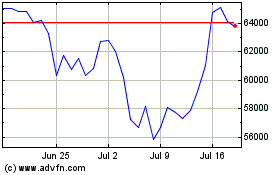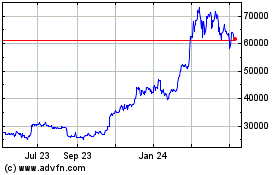It’s ‘Do Or Die’ For Bitcoin Price Soon, Says Analyst
June 20 2024 - 3:30AM
NEWSBTC
Josh Olszewicz, a renowned crypto analyst, has recently shared
critical insights into the immediate Bitcoin price future,
employing two technical analysis frameworks: the Ichimoku Cloud and
Bollinger Bands. These tools hint at pivotal moments that could
shape the trajectory of the Bitcoin price in the near to medium
term. Bitcoin Analysis Using The Ichimoku Cloud In the first chart
featuring the daily Ichimoku Cloud, Olszewicz highlights a critical
moment for Bitcoin as it navigates through this complex indicator.
The Ichimoku Cloud, known for providing support and resistance
levels as well as momentum and trend direction, shows Bitcoin
trading near the edge of the cloud. This is significant because a
break above the cloud could suggest a bullish outlook, while
falling below the cloud often signals bearish momentum. Here,
Olszewicz emphasizes a ‘do or die’ scenario for Bitcoin. The price
of Bitcoin, as recorded last on the chart at $64,570, approaches
the edge of the cloud. “No one likes an ultimatum but it’s do or
die here pretty soon on the daily BTC cloud,” warned. Related
Reading: IntoTheBlock Reveals Fact About Current Bitcoin Situation
Analysts Are Puzzled By A significant aspect of the Ichimoku Cloud
chart is the relationship between the Tenkan-Sen (red line) and the
Kijun-Sen (blue line). The Tenkan-Sen, which is a shorter-term
moving average, remains above the Kijun-Sen, a longer-term moving
average, indicating a positive momentum in the short run. Bollinger
Bands Weekly Analysis Moving to the weekly chart equipped with
Bollinger Bands, Olszewicz discusses another potential inflection
point. Bollinger Bands serve as a measure of volatility—narrow
bands suggest low volatility while wider bands indicate higher
volatility. The Bitcoin chart shows a tightening of these bands
around the current price level, which may precede a significant
price movement, often referred to as a “Bollinger Band Squeeze.”
The fact that Bitcoin is hovering just above the midline (the
20-period moving average) of the Bollinger Bands at $64,238 points
to a tenuous balance between buying and selling forces. However,
the narrowing of the bands is particularly notable because it could
lead to a decisive breakout or breakdown, depending on other market
factors and trader sentiment. If Bitcoin breaks below the midline,
the next support could be found at the lower Bollinger Band,
currently positioned around $51,792, which could represent a
significant downturn in price. Conversely, should Bitcoin bounce
off the midline and gain upward momentum, it might target the upper
Bollinger Band, situated at approximately $76,684, indicating a
potential rally. Related Reading: Ikigai Founder Explains Why
Bitcoin And Crypto Are ‘On The Verge Of Cannibalism’ The analyst
points out that understanding the implications of a Bollinger Band
Squeeze could be crucial for traders, as such periods of low
volatility often end in sharp price moves. “If you didn’t like the
Cloud ultimatum, here’s the weekly BBands,” remarked Olszewicz.
Both charts, though using different analytical tools, converge on a
similar narrative: Bitcoin is at a potential turning point that
could define its price action for the coming days or weeks. The
current levels close to the upper boundaries of both the Ichimoku
Cloud and the Bollinger Bands underscore the tension in the market.
At press time, BTC traded at $65,494. Featured image created with
DALL·E, chart from TradingView.com
Bitcoin (COIN:BTCUSD)
Historical Stock Chart
From May 2024 to Jun 2024

Bitcoin (COIN:BTCUSD)
Historical Stock Chart
From Jun 2023 to Jun 2024
